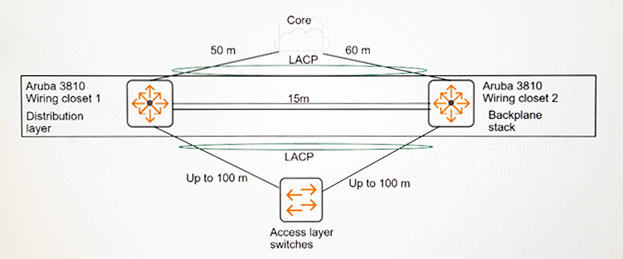Refer to the exhibit.

A company requires distribution layer switches that can provide Layer 2 and Layer 3 redundancy. The exhibit shows the proposal for these switches. Which change to the proposal will help meet the company's requirements?
Refer to the exhibit.

A company requires distribution layer switches that can provide Layer 2 and Layer 3 redundancy. The exhibit shows the proposal for these switches. Which change to the proposal will help meet the company's requirements?
The proposed switches should be replaced with switches that support VSF to support the required distance between stack members. Virtual Switching Framework (VSF) is designed to handle greater distances between switches and provides necessary redundancy. The given exhibit implies a need for enhanced L2 and L3 redundancy over significant distances, which backplane stacking cannot handle due to its distance limitations. Therefore, switches that support VSF are more suitable for the company’s requirements.
Answer is D. 2930M's 3 meter backplane cabling isn't long enough. BUT 2930F's do however (up to 4 switches)support VSF over the front so you can use either SFP+ or Ethernet and that gets us past the 15 meter limit. Another requirement is redundancy. Not using a LAG takes us farther away from being redundant.
D is correct. Aruba 5406 & 2930F support VSF.
Answer is B. Surely the LAG hints for virtualization (i.e. VSF). However, backplane stacking between location is not feasible because it is a co-location model and distance is a factor. Also, 5400/2900 support VSF; 3800 and 2900M support backplane. Note: the adavtages of VSF is Eliminates the need for L2 redundancy protocols such as spanning tree (STP) and Eliminates the need for L3 redundancy protocols such as Virtual Routing Redundancy protocol (VRRP). Change the model to 5400s.
The solution must be B. Because of the distance between the switches. Backplane Standings support only 0.5/1/3m length.